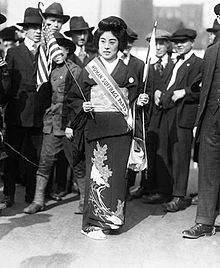Komako Kimura

Komako Kimura (1887-1980), also seen as Komaku Kimura or Komago Kimura in American newspapers, was a Japanese suffragist, actress, dancer, theatre manager, and magazine editor before World War II.
Early life
Komako Kimura trained as an actress from childhood.She also read Western authors in school, including feminist Ellen Key, whose writings Kimura particularly admired.[1]
Career
In 1913, Komako Kimura was cofounder of "The Real New Women's Association" (Shin Shinfujinkai)[2] and editor of its journal Shin shin fujin. She traveled to New York in 1917 to participate in a suffrage march, to study English and the strategies of American suffragists, and to raise funds for continuing Japanese suffrage efforts.[3] She made plans to publish a magazine in the United States, titled The Japanese Suffragist.[4]
Komako Kimura acted most of the female roles in Shakespeare (in Japanese), and managed two theatres in Tokyo.[5] "I am told that a dancing suffragist is something America does not quite understand," she commented in an interview in 1917. "We all have to have some means of a livelihood while we fight for our ideals."[3]
Personal life
Komaku Kimura was married to spiritual teacher and healer Hideo Kimura, and they had one son, born in 1909.[6] While living in New York, the Kimuras demonstrated Japanese physical disciplines and conducted religious ceremonies.[7][8]
References
- ^ "Japanese Actress is Here to Study the Feminist Movement" Star Tribune (May 26, 1918): 64. via Newspapers.com

- ^ Raichō Hiratsuka, In the Beginning, Woman was the Sun: The Autobiography of a Japanese Feminist (Columbia University Press 2010): 213-214. ISBN 9780231138130
- ^ a b "The New Women of Cherry Blossom Land" The Woman Citizen (August 11, 1917): 183.
- ^ "Japan" Woman Voter (October 10, 1918): 4. via Trove
- ^ "One Woman Who Dares" Daily Herald (January 15, 1918): 4. via Trove
- ^ "Mme. Kimura Here to Study Feminist Movement Which She Hopes to Promote in Her Native Land" Brooklyn Daily Eagle (April 28, 1918): 23. via Newspapers.com

- ^ "She's Somewhat Small, but Her Resistive Power, That's Different" Galveston Daily News (January 10, 1921): 3. via Newspapers.com

- ^ "Madame Hideo Kimura" Evening Public Ledger (August 1, 1919): 22. via Newspapers.com

External links
- A photograph of Kimura Komako in about 1926, from Getty Images.
